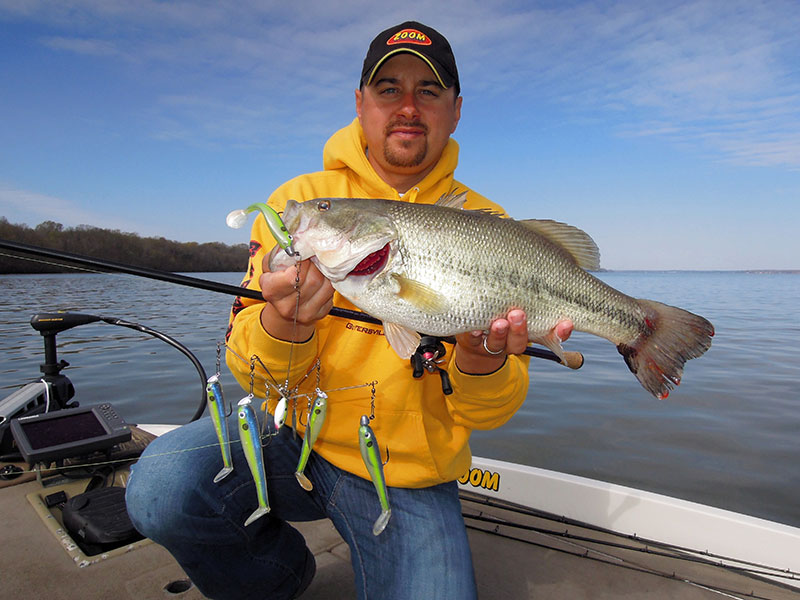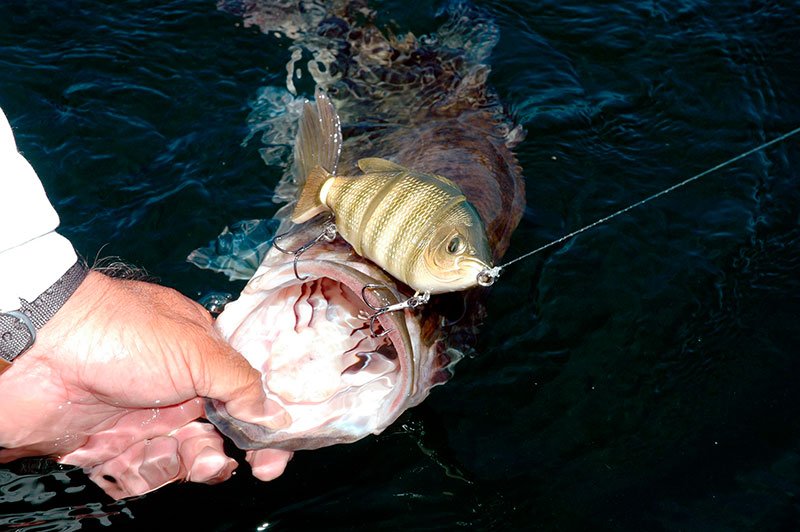 Try this triple threat approach to excite spring largemouths
Try this triple threat approach to excite spring largemouths
In early spring, anglers could catch their biggest largemouth bass of the year. Or, they could catch a limit of nice ones that may set the standard for the whole year.
Or both.
Before spawning, bass gorge themselves on shad and other baitfish. To match that natural feeding spree, three lures stand out for imitating baitfish: Alabama Rigs, swimbaits and jerkbaits. They are lures that every angler should have rigged and ready to chunk and wind for March bass madness.
Alabama Rig: To the bass, it looks like an all-you-can-eat buffet
Andy Poss of Muscle Shoals, Ala. developed the original Alabama Rig with five wires coming off a single lead that allows anglers to fish multiple baits simultaneously. People also call it an umbrella rig since the apparatus resembles an umbrella without the fabric.
“An Alabama Rig excels in cold water,” said Darold Gleason, a bass pro and Toledo Bend guide (337-397-8860, Facebook) from Many. “Winter and the pre-spawn are the best times to throw the A Rig. It works best in lakes with clear water and big bass. I’ve caught double-digit bass on Toledo Bend with it. Another time on Toledo Bend, I caught a 4-pounder and a 6-pounder on the same cast. I’ve caught up to four bass on one cast with the A Rig.”

Some rigs come with three wires or other configurations. Some add spinner blades for more enticement. Anglers can fish infinite lure combinations on the rig, but most people prefer soft-plastic swimbait tails on jigheads. Multiple baits mimic a baitfish school, triggering a competitive feeding instinct. It doesn’t look like a single bite of lunch; it looks like the whole buffet.
“In March, I use four 1/8-ounce jigheads and one ¼-ounce jighead in the center,” Gleason said. “I use baits relative to the size of the primary forage in that lake. Usually, I put 3-inch trailers on the outside and a 4- to 4.5-inch trailer in the middle. On a trophy bass lake like Toledo Bend, I use larger baits. For colors, keep it simple with shad colors.”
Umbrella rigs work particularly well for targeting suspended fish. In a place like Toledo Bend or Ross Barnett Reservoir in Mississippi, bass commonly suspend near flooded timber, large stumps, bridge or dock pilings and other vertical structure. Hungry bass might rise to attack a baitfish school fluttering over their heads. Anglers can also catch fish around sloping points, riprap, humps and ledges or other cover. The rig makes a magnificent enticement for schooling bass in open water.
“An A Rig is exceptional for tempting suspended fish,” Gleason said. “With forward-looking sonar, we can see fish and throw at individual bass. I work an A Rig like an open-water spinnerbait. I control the depth and how fast it sinks by the weight of the jigheads.”
Many anglers use a steady retrieve, but vary the speed to determine what attracts fish that day. Periodically, pause to let the rig sink a little. When the rig pauses, the wires flare, creating unusual movement and flash in the water. Fish regularly key on subtle changes.
Throwing such a heavy apparatus requires stout equipment and good control. Throw the rig on 7- to 8-foot medium-heavy to heavy rods with high-speed reels spooled with 50- to 80-pound-test braid.
“An A Rig is a super fun way for average weekend fishermen or kids to fish,” Gleason said. “It can catch many different species. It might catch anything in the water that eats baitfish.”
Swimbaits: These realistic lures offer a simple approach

Many people fish swimbaits on multi-bait rigs, but swimbaits can be highly effective by themselves, especially as the weather warms and bass turn more aggressive. These soft, realistic lures replicate baitfish in feel and action better than most other fish imitations.
“To bass, swimbaits look and feel natural,” said Gene Bishop, a Bassmaster Classic veteran and guide (601-941-9493, www.fish5work2.com) from Madison, Miss. “During a warming trend, I get on the flats in about two feet of water and throw a black and blue or white 4.5-inch Reaction Innovations Skinny Dipper rigged with a 4/0 Owner swimbait hook with a small willow-leaf spinner on the bottom of it.”
Swimbaits produce vibrations, but they primarily attract fish by sight because they look like something a bass would naturally eat and create a swimming action when retrieved. When fishing swimbaits, try to “match the hatch.” For instance, if bass key upon 3-inch minnows in whitish colors, toss lures similar in size, shape and color to their natural prey.
For most swimbaits, simply attach a soft-plastic tail to a jighead. A jighead allows anglers to easily switch trailer colors, sizes or shapes. Other baits come equipped with internal weights.

Many people work swimbaits with a steady retrieve so the bait “swims” like a natural fish with enticing wobbling action. In deeper water, hop swimbaits along the bottom almost like working a Texas-rigged worm. In cold water, keep baits just off the bottom or slightly above deep structure.
“I slow-roll a swimbait around cover like rocks and grasses,” Bishop said. “A swimbait is hard to beat in any lake with clean water. In very clear water, I throw a green pumpkin bait because it looks like a bream.”
Also try the stop-and-drop approach. Periodically pause the retrieve so the bait sinks like a dying baitfish. A baitfish in distress kicks in bass feeding instincts, giving it an opportunity to snatch an easy morsel. Bass frequently bite “on the fall.” After letting the bait sink a foot or two, depending upon the water depth, resume the retrieve.
“I work a swimbait with a simple cast and retrieve, just like a spinnerbait,” Gleason said. “I’ll often use single swimbaits on 3/8-ounce open jigheads with a hollow-belly trailer when fishing open water. Sometimes, I’ll go up or down a size depending on the depth we’re fishing that day.”
Some larger hard swimbaits almost look like full-sized bluegills, gizzard shad or other fish. Big swimbaits work best in lakes with robust populations of large baitfish and plentiful monster bass, like Toledo Bend, Caney Lake or Ross Barnett. Any strike on these supersized temptations could produce the bass of a lifetime.
“When someone throws big swimbaits, they aren’t fishing for a lot of bites, but one big bite,” said Paul Elias, a Bassmaster Classic champion from Laurel, Miss. “For big fish, I like jointed baits that look like a bluegill or gizzard shad. Through the years, I’ve caught many big fish on swimbaits.”
Around grass or shallow woody cover, insert the hook into the plastic body to make the lure weedless. Let the bait sink to the grass tips and work it over submerged vegetation or structure.
“When bass get down in the grass or laydowns, I use 1/8- or ¼-ounce weedless keel-weighed hooks with hollow-belly swimbaits,” Gleason said. “Rigged that way, it’s much more weedless than a spinnerbait. I can throw it up on the bank and drag it off. When it gets to the shoreline, drop-off or weeds, let it sink a couple feet and slow-roll it back.”
Jerkbaits: These suspending lures dare the bass to bite
Jerkbaits resemble long, skinny baitfish. Some float and some suspend or slowly sink. Slow-sinking and suspending jerkbaits weigh a bit more than floaters. Some sinkers come with rattles for added enticement. The short lip on each type creates an erratic zigzag motion.

“I generally use suspending jerkbaits,” Gleason said. “Often, big female bass suspend around flooded timber before they go to spawn. The water might be 10 to 15 feet deep, but the bass suspend six or eight feet down. They get higher in the water column to let the sun warm them before going to the bank. If bass stay a little too deep, I’ll add suspend strips to my jerkbait or add bigger hooks so the bait slowly sinks as I work it.”
Fishing slow-sinking and suspending jerkbaits takes considerable patience. For a faster descent, jerk the rod to make the bait dive with a darting motion. Then pause. When the retrieve stops, the bait hovers, daring bass to strike.
“In March, if the water is still cold, but clean and the fish are suspended, a suspending jerkbait can be highly effective,” Bishop said. “For suspended fish, I reel it five turns and then stop. I’ll do a jerk, jerk pause retrieve.”
Made from wood or plastic, floating jerkbaits work great over weedy flats and along shallow shorelines. When jerking the rod, the lure disrupts the surface like a fish striking. It dives, but then the buoyant bait floats back to the surface. Anglers can also wake jerkbaits just below the surface or run them with a wobbling retrieve two to three feet deep. When fishing submerged grass, run the bait just above the vegetation.
“Once the water starts warming, I go to a floating jerkbait, like the Rapala Original Floating Minnow,” Bishop said. “I’ll let it sit on the surface a few seconds, then jerk it and keep repeating. I’ve caught bass in the 7-pound range on jerkbaits at Ross Barnett Reservoir. Jerkbaits would be great to use during the spring in any lakes with clean, clear water.”
And they’ll work on just about any lake in Louisiana.
For fishing lighter floaters, use spinning tackle equipped with 8- to 12-pound-test monofilament line. For suspending jerkbaits, use a 7-foot medium-light to medium rod with 12-pound-test fluorocarbon line, which sinks faster than monofilament and virtually disappears in the water.
Any of these baits could put more bass in the boat this spring. And any cast in March might produce the lunker of a lifetime.


